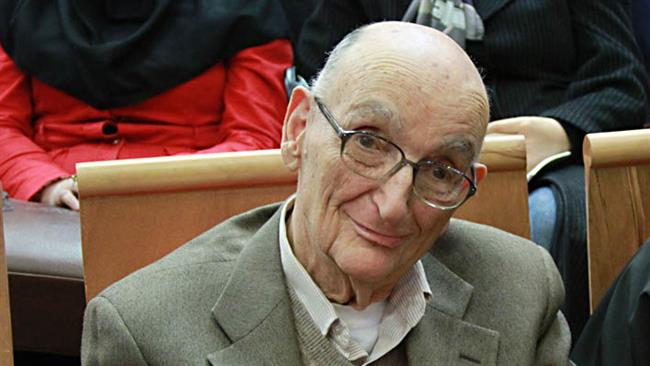
1. Renowned translator Keikavus Jahandari dies
Iranian translator Keikavus Jahandari, famous for his translations from German of works like Hermann Hesse ‘s “Steppenwolf” passed away at age 91.Born in 1923 in Tehran, Jahnadari was a University of Tehran alumnus in foreign languages. He also served as a lecturer and teacher of Farsi in The Goethe University Frankfurt in 1960.He has rendered many German books, especially novels, into Persian, with the most famous of them being Der Steppenwolf by Swiss German poet and writer Hermann Hesse. Jahandari’s translation of the novel was first published in Iran in 1966.Jahandari was also a respected researcher and writer. He once served as the head of the department of foreign resources at the Center for the Great Islamic Encyclopedia.
[PressTV]
2. Iranian publishers, illustrators to attend Bologna Children’s Book Fair
Four Iranian publishers and three illustrators will attend the Bologna Children’s Book Fair, which will be held in the Italian city from March 30 to April 4, reports Tehran Times.
Blue Bird Books, Elmi Farhangi children’s books division, the IDCYA (Institute for the Intellectual Development of Children and Young Adults, the Iran Cultural Fairs Institute (ICFI) and the Shabaviz Publishing Company will put their latest offerings on display at the fair. Works by three Iranian artists Fereshteh Najafi, Narges Mohammadi and Fatemeh Qasemi are scheduled to be showcased at the Illustrators’ Exhibition, which will be held on the sidelines of the book fair.
3. Serbian kids can learn Persian at School
The Ministry of Education, Science and Technological Development of Serbia has announced that Persian language courses will be held at schools across Belgrade in the coming school year of 2015-2016, IRNA writes.
Perunicic Allen said that the ministry has given its approbation for the coming school year and Persian language will be the ninth foreign language to be taught to students across the capital Belgrade. Several Serbian universities including University of Belgrade and the University of Novi Sad, are currently hosting Persian language courses.
4. Rubaiyat of Omar Khayyam published in five languages
The Rubaiyat of Omar Khayyam, the masterpiece of the Persian mathematician, astronomer and poet, Omar Khayyam Neyshaburi, has recently been published in the five languages of Persian, English, French, German and Arabic. The great task of translation has been undertaken by scholar Hossein Elahi Qomshe’i. The book carries the translation of a collection of the Rubaiyat of Omar Khayyam by the English writer Edward Fitzgerald, and interpretation of 40 pieces of peotry by Dr Qomshe’i. Abolqasem Etesamzadeh, Amir-Hushang Kavusi, Kamran Jamali, Ebrahim Ariz, Mohammad Sabaei, and several other scholars collaborated in the translation of the book into other languages.
5. ‘History of Persian Language’ published in Urdu
According to IBNA, a book on the history of Persian language written by Mohsen Abolqasemi and translated to Urdu by Mohammad Sarfaraz Zafar is released in Pakistan. The book’s intended readers are the students of Persian language and literature, the students of Iranian ancient languages and general linguistics as well as anyone interested in learning more about Persian letters.
6. Goli Taraghi attends the unveiling ceremony of her latest book in Tehran

On late January 2015, Goli Taraghi’s latest book launch was held in ‘Ayandeh’ Bookstore, where a number of eminent literay figures including Taraghi herself gathered and commemorated her lifelong literary acievements. Iraj Parsinejad and philosopher Dariush Shayegan and a number of young fans were among the attendants who received a signed copy of Taraghi’s latest short story collection ‘Happening’. [IBNA]
7. Sangelaj Stage welcomes the Conference of the Birds
.jpg)
An adaptation of Attar Neyshabouri’s “The Conference of the Birds”, one of the greatest Muslim works of mysticism is being staged at Tehran’s Sangelaj Hall.
The play entitled “The Delightful Fragrance of Simiorgh” is directed by Ali-Naqi Razzaqi. “Thirty birds begin an odyssey to maintain spiritual purity in this play that I wrote based on ‘The Conference of the Birds’,” Razzaqi told the Persian service of the Mehr News Agency on Sunday. “I tried to be loyal to the original story, because I think that the story has been misunderstood by directors like Peter Brook, who previously staged a play based on ‘The Conference of the Birds’,” he added.
Manteq al-Teyr (The Conference of the Birds) is an allegorical poem describing the quest of the birds (i.e., Sufis) for the mythical Simorgh, or Phoenix, whom they wish to make their king (i.e., God). In the final scene the birds that have survived the journey approach the throne contemplating their reflections in the mirror-like countenance of the Simorgh, only to realize that they and the Simorgh are one.
The troupe had previously performed the play in Shiraz in September 2014.
[see here]

Leave a Reply